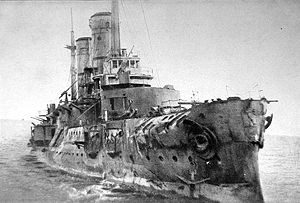Battle of Moon Sound
| Battle of Moon Sound | |||||||
|---|---|---|---|---|---|---|---|
| Part of Eastern Front (World War I) | |||||||
 The Russian pre-dreadnought Slava sinking off Saaremaa, October 1917. |
|||||||
|
|||||||
| Belligerents | |||||||
|
|
|
||||||
| Commanders and leaders | |||||||
|
|
|
||||||
| Strength | |||||||
| 1 battlecruiser, 10 battleships, 9 light cruisers, 1 Mine cruiser 50 destroyers, 6 submarines, transports |
3 cruisers, 3 gunboats, 21 destroyers |
||||||
| Casualties and losses | |||||||
| 2 torpedo boats, many ships damaged by mines |
1 pre-dreadnought, 1 destroyer, 1 submarine |
||||||
The Battle of Moon Sound was a naval battle fought between the forces of the German Empire, and the then Russian Empire (and three British submarines) in the Baltic Sea from 16 October 1917 until 3 November 1917 during World War I. The German intention was to destroy the Russian forces and occupy the West Estonian Archipelago. The Imperial German Navy had 1 battlecruiser, 10 battleships, 9 light cruisers, 1 mine cruiser, 50 destroyers and 6 submarines while the Russians had only 2 pre-dreadnoughts, 3 cruisers, 3 gunboats, 21 destroyers, plus the 3 British submarines.
It was the Germans' intention to destroy the Russian Army and occupy the West Estonian Archipelago (Moonsund Archipelago). The Germans captured the archipelago, with its main islands of Saaremaa (Ösel), Hiiumaa (Dagö), and Muhu (Moon) during Operation Albion in September 1917. This left a Russian squadron consisting of the old Russo-Japanese War-era pre-dreadnought battleships Grazhdanin (Tsesarevich), and Slava, together with cruisers and destroyers, stranded in the Gulf of Riga. The Russian fleet escaped on 17 October 1917 by way of the Suur Strait separating the island of Muhu from the Estonian mainland.
At the start of the Battle of Moon Sound, there were two British submarines in the Gulf of Riga. They were C 27 (Lt. Sealy) and C 32 (Lt. Satow). When the Germans got there, Captain Francis Cromie sent out another submarine called C 26 (Lt. Downie). On the night of the 16th of October, Lt. Sealy fired two torpedoes at two German ships but missed. Two further torpedoes struck their targets. C 27 returned to Hanko when it was no longer needed. C 32 attempted to attack a German ship but was spotted and bombed. In the afternoon of 16 October, Gruppe Behncke travelled to the south exit of the Suur Strait and dropped anchor around 8:30 pm. All German ships were anchored in a close line with a torpedo boat at each end. The Germans made significant progress on shore on 16 October, taking 120 officers and 400 men prisoner and capturing 49 guns. By the end of the day, German forces were prepared to capture the West Estonian Archipelago and the navy was ready to attack in the Matsalu Bay and the Suur Strait.
...
Wikipedia
